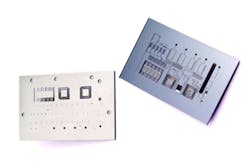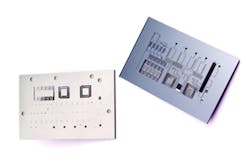imec, Panasonic Collaborate on SNP Detection
imec and Panasonic have jointly developed a fully integrated silicon chip about half the size of a credit card that performs fast, simple, and sensitive detection of genetic markers—specifically single nucleotide polymorphisms (SNPs). In a recent phone interview, imec’s Professor Liesbet Lagae, R&D manager, Life Science Technologies, and Paolo Fiorini, technical project leader, commented on the project.
Professor Lagae described the project as a collaboration between Panasonic and imec that has been in place for several years. Now, she said, “We have actually achieved one of the most important milestones, which is actual proof of concept with the first demonstration of the chip for SNP detection.”
P-TAS Chip for Fast Detection of Genetic Markers
Courtesy of imec
Fiorini cited very close cooperation between the two organizations: “There has always been a person from Panasonic working at imec during the development—so it’s really a cooperative project.” Panasonic plans to commercialize a benchtop instrument that will work with the chips to perform the SNP analysis in a clinical setting.1
SNPs are variations in a single DNA base among individuals. The detection of SNPs makes it possible to check whether patients are predisposed to acquiring hereditary diseases and to determine how they might respond to pharmaceuticals.
Professor Lagae described imec as “…a major semiconductor research company organized as a nonprofit organization with a lot of industrial partners that work with us onsite in Leuven on different topics.” In addition to semiconductor research, she said, the organization has been working on research into life sciences, and she described the SNP chip as “…probably one of the first real life-science devices that imec has come out with.”
Using Standard Silicon Technology
The project starting point, she explained, centered on the fact that the chip should, as much as possible, be built using standard silicon technology—a core strength of imec. “The process is very much MEMS-like,” she said, “so it includes reactive ion etching of deep channels on silicon.” She added, “Challenges are mostly related to how to keep it simple: How can you provide a compact device in silicon but also include the major external requirements in terms of thermal control and mechanical mounting and so on in a very compact footprint?”
The chip integrates a variety of structures and sample preparation modules, including microfluidic conduits, filters, mixers, and miniaturized polymerase chain reaction (PCR) cyclers and sensing elements onto a single disposable device. Fiorini cited a key aspect of bringing all such structures together on one chip relates to imec’s silicon processing expertise. “We developed the capability of fabricating on the same chip—and with a very high reliability—structures that have a very fine grain, like micropillars with one micrometer distances, and structures that have a very large size,” he said.
With deep reactive ion etching, he said, “It’s not obvious how to combine devices with different dimensions and different aspect ratios and have good results.” He added, “We have a special process that allows us to couple these two types of features—high and low aspect ratios.” The process is important not only as an enabler for the microfluidic platform for use with the Panasonic project, but it can be reused for other applications. “It is very versatile because almost any type of structures can be fabricated on silicon,” Fiorini said.
Professor Lagae said typical life-science microfluidic manufacturers struggle with making very complex combinations of microfluidic functions on a very small footprint. “However,” she said, “the silicon process works with very fine feature sizes that combine with larger feature sizes on one chip in a pretty compact format. Silicon allows us to combine all these functions and keep the total footprint very compact.”
As to the current status of the project, Professor Lagae said Panasonic at this point is actively searching for partners to work toward commercialization. “Commercialization is going on rather effectively from Panasonic’s side,” she said. “It’s not yet at the clinical test stage, but the customer is actively evaluating the chip.”
Bridge to Production
Professor Lagae noted that commercialization is entirely led by Panasonic, but so far, all the chips are manufactured at imec. Ultimately, Panasonic may employ a third-party foundry, but she said imec is one of the candidates. “If volume becomes really large, probably imec is not the most interesting partner. But for small-volume manufacturing, imec can act as a production bridge for Panasonic and provide a sufficient number of chips for customers.”
She said it’s a common misconception that imec only produces small quantities of chips for research and prototyping. That had been true, she said, but two or three years ago, imec began producing production devices. As an example, she cited a UV sensor produced for ASML for use in its extreme ultraviolet lithography equipment. “So ASML tools have imec inside,” she said. As another example, imec produces disposable silicon photonics biosensor chips for Genalyte to be used in its diagnostic and molecular detection equipment.
Further, she said, imec produces chips for some of its spinoffs. “We are starting to understand everything that is required for process manufacturing quality and all the things necessary to be able to ramp up for small-volume production or to bridge between the small-volume requirements, which are typical at the beginning of a new project like the Panasonic device, toward the large volumes that probably would not be produced at imec.”
Addressing Development Challenges
“We succeeded in the Panasonic project,” Professor Lagae commented, [because] “we have been able to combine all the functions in one silicon device [by] combining the process that’s required for small features and the process that’s required for larger features.”
Fiorini added, “I think an important contribution to the compactness of the chip also comes from the Panasonic integrated pumps. Panasonic has a few patents and certain expertise in fabricating small pumps based on conductive polymers, so this allows us to make the chip rather compact, because the pump can be inserted in the chip itself. This is something that is not very common, and we consider it as a peculiar part of our system.”
Professor Lagae said another contribution to the project has been the biochemical flow protocol needed on the chip. “It is similar to versions that have been implemented on conventional laboratory tools,” she said, “so it seemed that we were able to optimize this pretty fast.”
She added, “I think one of the important points here is that silicon actually is a pretty nice material to perform biochemistry on. It’s pretty inert and pretty well sealed. There are issues that other companies have had trouble with in microfluidics that we didn’t have using silicon.”
Fiorini added, “Another important technical aspect of our device is the thermal isolation. We perform PCR in a small volume cavity—1 to 3 µL.” He described it as a microreactor with a special design that keeps it thermally insulated from the rest of the chip. The thermal mass of the microreactor is very small, he said, which provides for very short thermal time constants and allows faster temperature cycling.
Added Professor Lagae, “One of the different features of the entire system is that it will indeed do the PCR required for the single nucleotide in very short time—nine minutes. This is much faster than we have seen so far with competing microfluidic providers, and that has to do with the compact realization of the thermal reactor in silicon.”
Cost Issues
Cost is a typical question the team is asked, said Professor Lagae. She said, “The answer is not so obvious. Silicon has its costs, but what we see is that microfluidics has its costs everywhere.” At volumes much higher than those envisioned for devices like the Panasonic chip, she said, silicon would be a very expensive choice. “But for the volumes that we are speaking about,” she said, “silicon is a very interesting choice, especially because of the technical differentiators such as compactness, speed, and full analysis being done in one chip.”
Explained Fiorini, “With competing technologies—for example, like molding—if you have to prepare the mold and then you are going to sell only a few thousands of chips, obviously that would be very expensive. So in our opinion, with silicon, we win over these other technologies until volume is relatively high. Only for extremely high volume might silicon start to lose.”
He added that costs relate not only to the silicon fluidic chip, but also to the full cost of the cartridge used with the benchtop machine. “At the moment, we think that the cost of silicon, which is considered by many players in the field as a handicap, is not really an issue,” Fiorini said, “and the capabilities of silicon are so much wider because whenever you need to use very small sizes or whenever you need no shrinkage because of temperature, silicon is certainly superior to other materials.” He added, “We also are working on polymer fluidics, so we do not say that the silicon is the only solution for any microfluidic device, but we think it has a lot of potential.”
Professor Lagae added, “At high volumes, perhaps silicon is not competitive anymore, so then we have to compare with micromolding companies, and micromolding companies today have not been able to realize all the functionalities” that imec can realize in silicon.
Professor Lagae expects the benchtop instrument to be used in small medical centers serving a few doctors who don’t work according to the very centralized procedures being used today in major hospitals. Fiorini added that the instrument also could find application in larger diagnostic centers and hospitals to quickly help identify effective treatments for cancers and other serious diseases. They noted that SNPs have been identified that indicate drug resistances, certain fetal syndromes, neurological disorders, and predispositions to cancers and other serious diseases.
They concluded by noting that the ongoing success of the project relates to the close cooperation between the imec and Panasonic teams.
Reference
Kennedy, D., and Osuga, R., “DNA testing chip delivers results in one hour, paves way for personalized drug treatments,” DigInfo TV, April 4, 2013.

